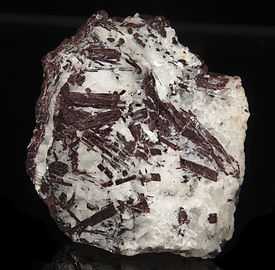Piemontite
From Wikipedia, the free encyclopedia
| Piemontite | |
|---|---|
 Piémontite from the type locality: Prabornaz Mine, Italy | |
| General | |
| Category |
Sorosilicates Epidote |
| Formula (repeating unit) | Ca2(Al,Mn3+,Fe3+)3(SiO4)(Si2O7)O(OH) |
| Identification | |
| Color | Reddish-brown, reddish-black |
| Crystal habit | Slender prismatic, blocky to massive |
| Crystal system | Monoclinic 2/m |
| Twinning | On [100] uncommon |
| Cleavage | [001] good, [100] distinct |
| Fracture | Uneven to splintery |
| Tenacity | Brittle |
| Mohs scale hardness | 6 - 6.5 |
| Luster | Vitreous |
| Streak | Red |
| Diaphaneity | Translucent to nearly opaque |
| Density | 3.46 - 3.54 |
| Optical properties | Biaxial (+) 2V = 64 - 106 |
| Refractive index | nα = 1.725 - 1.756 nβ = 1.730 - 1.789 nγ = 1.750 - 1.832 |
| Birefringence | δ = 0.025 - 0.076 |
| Pleochroism | Visible |
| Dispersion | r>v very strong |
| References | [1][2][3] |
Piemontite is a sorosilicate mineral in the monoclinic crystal system with the chemical formula Ca2(Al,Mn3+,Fe3+)3(SiO4)(Si2O7)O(OH).[1] It is a member of the epidote group.[3]
Red to reddish-brown or red-black in colour, Piemontite has a red streak and a vitreous lustre.[3]
The type locality is the Prabornaz Mine, in Saint-Marcel, Aosta Valley, Italy.[3]
It occurs metamorphic rocks of the greenschist to amphibolite metamorphic facies and in low-temperature hydrothermal veins in altered volcanic rocks. It also occurs in metasomatized deposits of manganese ore. Associated minerals include: epidote, tremolite, glaucophane, orthoclase, quartz and calcite.[1]
References
- ↑ 1.0 1.1 1.2 http://rruff.geo.arizona.edu/doclib/hom/piemontite.pdf Handbook of Mineralogy
- ↑ http://webmineral.com/data/Piemontite.shtml Webmineral
- ↑ 3.0 3.1 3.2 3.3 Mindat reference page for Piemontite

Piemontite on Quartz, from No. 5 shaft, Messina mine, Limpopo Province, South Africa. Red piemontite microcrystals cover three sides of a doubly terminated quartz crystal. Size: 7.1 x 3.0 x 2.6 cm.
| Wikimedia Commons has media related to Piemontite. |
| ||||||||||||||||||||||||||||
This article is issued from Wikipedia. The text is available under the Creative Commons Attribution/Share Alike; additional terms may apply for the media files.